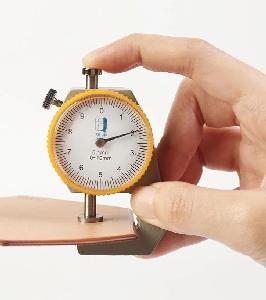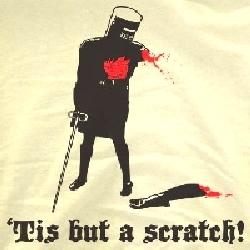-
Posts
5,928 -
Joined
Content Type
Profiles
Forums
Events
Blogs
Gallery
Everything posted by fredk
-
If that one works for you - thats just grand so it is. I have one and never use it as its only good for measuring at the edge. Tandy used to sell one like that but it was in steps, like an Aztec temple, rather than the smooth triangle. I ordered the step one and got the other I use mine to search out thicker or thinner parts on a hide or piece of leather for certain projects.
-
Thanks for pointing that out That must have gone up in just the last couple of hours cos I was on the site about 2 hours ago and it weren't there then
-
I prefer to dye just as you've put it; cut, punch holes, sewing groove if required, then assemble the item.
-
-
Wot they mean is its not suitable on leather that's not been dyed/finished as it doesn't rub off that too easily but I've used it on undyed leather and most of the pen marking has come off, the rest was hidden under the sewing
-
If I'm following you correctly; I use one of those Tandy markers. I draw the sewing line with the pen, sew and then wipe off the pen line https://www.tandyleather.world/products/leather-marking-pen?_pos=1&_sid=1d5573148&_ss=r very much worth having in the sewing and in the cutters box. I think I have about 6 around my benches, always having one close to hand
-
Back on to the topic; Whilst these embroidered sandals and slippers did exist, when they appear on statues what in real life is a soft and only slightly raised embellishment is depicted in hard strong and deep relief. Europe's Cathedrals and Churches have very many effigies of knights, kings and such where a design painted or sewn on to their surcote is depicted in 3 dimensions and was originally painted "Romanes eunt domus"
-
A cheaper alternative to those fancy pins is a mapping pin into a small block of cork
-
You see your knife sheath there? If you clamp it up with lengths of lolly (popsicle?) stick along the shape you can get a nice sharp line along the blade edge
-
I use either scraps of leather or pieces of lolly sticks between the bulldog clamps and the leather. Which I use depends on a: what come to hand or b: the shape of the glued line Lolly sticks spread the clamping load better and leather will conform to a curve better I've left things clamped up like this for days or weeks, not usually deliberately but because I've forgotten to finish the item or I've been waiting on something to finish it off
-
you're "just a very naughty boy!" "Ah, Camelot! On second thoughts, lets not go there, its a silly place"
-
1. remember google is only as good as what people put up on the internet. There is a fair bit of mis-information posted up by people who 'think' they know. 2. Is a long time since I read the books, they were on loan to me. but a. its a myth that Romans wandered around wearing just sandals and togas speaking latin b. keeping to footwear; just as people do today, Romans and Greeks wore sandals in hot weather, wearing full vamp shoes in cold weather or cold countries, eg Britannia, look up; vindolanda, shoes c. keeping to these style of sandals; they were made of multiple layers of silk, embroidered with copper and silver wire and gold thread. Many of the very upper class had them and they were passed down the family line. Thus some survived a long time and ended up in museums. They evolved into full vamp soft shoes, which we would call slippers, still made of silk and heavily embroidered with silver and gold thread, worn by medieval kings and lords. Usually only worn inside around their palaces and castles, reserving their thicker leather boots for outside, rather like what we do today. Nothing really changes that much
-
Only in very specialised books by archaeologists. Not the sort of books you find through Amazon or your local book store. These are books written as research papers by archaeologists and only a small number of copies are printed up, thus they are very expensive. You need to contact archaeologists or museums directly to find out if such publications by them exist. Very often a museum will direct you to their 'visitors shop' for mainstream books
-
Thanks for all the answers everyone
-
Those weren't fully leather. They were embroidered silk uppers with leather soles. Some examples still survive in the storage boxes of certain museums
-

Transporting Industrial Sewing Machine
fredk replied to LePoisson's topic in Leather Sewing Machines
May I add a few suggestions? 1. if you have to unscrew or unbolt a piece, put the screw or bolt back into its hole. A bit of duct tape over it will help hold it from unscrewing again 2. put any removed parts into plastic bags with a big piece of paper saying what it is and where it came off. 3. during any dismantling take loads of photos, to show the part in place and that place without the part learnt by experience of not doing the above -
Tell me somat please; this thread applicator does not appear to have dogs for moving the leather between stitches, so do you have to move your item along and sort-of guess where to put the next stitch? With pre-punched holes you'd just be aiming the needle into that hole?
-

When You're Not That Into Leatherwork...
fredk replied to Sheilajeanne's topic in Archery Quivers and Bow Cases
If he doesn't toe-the-line he'll end up a resident of Boot Hill He's just keeping in-step with modern ideas on recycling/repurposing things -
Now knowing that it might need some lots of fettling to get it to work decent I might get one to play with Its what my father used to call a Tinker-toy* * I believe there used to be some sort of toy in the US that was called Tinkertoy
-
Is this the type of machine youse are discussing? I was thinking of buying one. Just cos I think its rather an antiquated & basic look which I like. I doubt I'd do any real sewing on it anyways. I can get this off ebay.uk, UK stock, for about £60 delivered
-
If you want to make your wallet or other credit/debit card holder RFID blocked, there is no need for expensive blocker stuff. I use a thin aluminium self-adhesive tape meant for plumbers to wrap around pipes. It cost me about £5 for a 50m x 5cm roll. I've High Street tested it on as many car readers as I could find, over 20 different types, and the tape blocked every time This, (not the exact same roll wot I bought https://www.toolstation.com/aluminium-foil-tape/p97723)
-
Do you have any builder's merchants? Places dedicated to just the professional building trade? I used to get hardware from a builders merchant. It was both superior, better quality and cheaper than the DIY type hardware places Without an image I cannot really think of what you are looking for but builders merchants often keep a variety of types of chain; for fencing, chain-loop locks et cetera. I used to get one heavy duty type to make tyre winter-chains, another type for keeping certain livestock tied up, another type for the chain-loop locks on gates and trailers and my motorcycle.
-
A good sharpening is all needs I like to use this wee gadget to keep the cutting edges right whilst sharpening https://www.tandyleather.world/collections/tools/products/craftool-keen-edge-sharpener
-

Secondary Leather/Keeping Costs Reasonable
fredk replied to livewire516's topic in Leatherwork Conversation
Maybe use regular upholsters' canvas webbing across the frame under the leather seat ?




